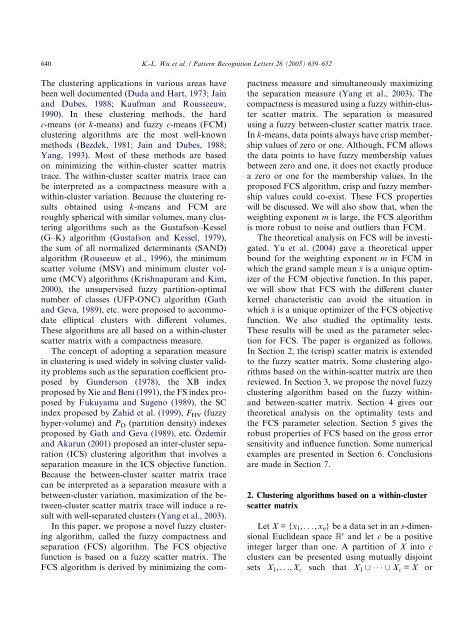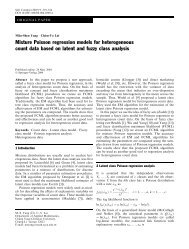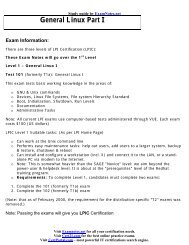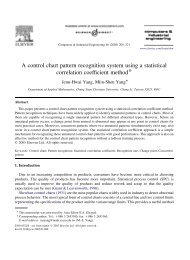A novel fuzzy clustering algorithm based on a fuzzy scatter matrix ...
A novel fuzzy clustering algorithm based on a fuzzy scatter matrix ...
A novel fuzzy clustering algorithm based on a fuzzy scatter matrix ...
Create successful ePaper yourself
Turn your PDF publications into a flip-book with our unique Google optimized e-Paper software.
640 K.-L. Wu et al. / Pattern Recogniti<strong>on</strong> Letters 26 (2005) 639–652<br />
The <str<strong>on</strong>g>clustering</str<strong>on</strong>g> applicati<strong>on</strong>s in various areas have<br />
been well documented (Duda and Hart, 1973; Jain<br />
and Dubes, 1988; Kaufman and Rousseeuw,<br />
1990). In these <str<strong>on</strong>g>clustering</str<strong>on</strong>g> methods, the hard<br />
c-means (or k-means) and <str<strong>on</strong>g>fuzzy</str<strong>on</strong>g> c-means (FCM)<br />
<str<strong>on</strong>g>clustering</str<strong>on</strong>g> <str<strong>on</strong>g>algorithm</str<strong>on</strong>g>s are the most well-known<br />
methods (Bezdek, 1981; Jain and Dubes, 1988;<br />
Yang, 1993). Most of these methods are <str<strong>on</strong>g>based</str<strong>on</strong>g><br />
<strong>on</strong> minimizing the within-cluster <strong>scatter</strong> <strong>matrix</strong><br />
trace. The within-cluster <strong>scatter</strong> <strong>matrix</strong> trace can<br />
be interpreted as a compactness measure with a<br />
within-cluster variati<strong>on</strong>. Because the <str<strong>on</strong>g>clustering</str<strong>on</strong>g> results<br />
obtained using k-means and FCMare<br />
roughly spherical with similar volumes, many <str<strong>on</strong>g>clustering</str<strong>on</strong>g><br />
<str<strong>on</strong>g>algorithm</str<strong>on</strong>g>s such as the Gustafs<strong>on</strong>–Kessel<br />
(G–K) <str<strong>on</strong>g>algorithm</str<strong>on</strong>g> (Gustafs<strong>on</strong> and Kessel, 1979),<br />
the sum of all normalized determinants (SAND)<br />
<str<strong>on</strong>g>algorithm</str<strong>on</strong>g> (Rouseeuw et al., 1996), the minimum<br />
<strong>scatter</strong> volume (MSV) and minimum cluster volume<br />
(MCV) <str<strong>on</strong>g>algorithm</str<strong>on</strong>g>s (Krishnapuram and Kim,<br />
2000), the unsupervised <str<strong>on</strong>g>fuzzy</str<strong>on</strong>g> partiti<strong>on</strong>-optimal<br />
number of classes (UFP-ONC) <str<strong>on</strong>g>algorithm</str<strong>on</strong>g> (Gath<br />
and Geva, 1989), etc. were proposed to accommodate<br />
elliptical clusters with different volumes.<br />
These <str<strong>on</strong>g>algorithm</str<strong>on</strong>g>s are all <str<strong>on</strong>g>based</str<strong>on</strong>g> <strong>on</strong> a within-cluster<br />
<strong>scatter</strong> <strong>matrix</strong> with a compactness measure.<br />
The c<strong>on</strong>cept of adopting a separati<strong>on</strong> measure<br />
in <str<strong>on</strong>g>clustering</str<strong>on</strong>g> is used widely in solving cluster validity<br />
problems such as the separati<strong>on</strong> coefficient proposed<br />
by Gunders<strong>on</strong> (1978), the XB index<br />
proposed by Xie and Beni (1991), the FS index proposed<br />
by Fukuyama and Sugeno (1989), the SC<br />
index proposed by Zahid et al. (1999), F HV (<str<strong>on</strong>g>fuzzy</str<strong>on</strong>g><br />
hyper-volume) and P D (partiti<strong>on</strong> density) indexes<br />
proposed by Gath and Geva (1989), etc. Özdemir<br />
and Akarun (2001) proposed an inter-cluster separati<strong>on</strong><br />
(ICS) <str<strong>on</strong>g>clustering</str<strong>on</strong>g> <str<strong>on</strong>g>algorithm</str<strong>on</strong>g> that involves a<br />
separati<strong>on</strong> measure in the ICS objective functi<strong>on</strong>.<br />
Because the between-cluster <strong>scatter</strong> <strong>matrix</strong> trace<br />
can be interpreted as a separati<strong>on</strong> measure with a<br />
between-cluster variati<strong>on</strong>, maximizati<strong>on</strong> of the between-cluster<br />
<strong>scatter</strong> <strong>matrix</strong> trace will induce a result<br />
with well-separated clusters (Yang et al., 2003).<br />
In this paper, we propose a <str<strong>on</strong>g>novel</str<strong>on</strong>g> <str<strong>on</strong>g>fuzzy</str<strong>on</strong>g> <str<strong>on</strong>g>clustering</str<strong>on</strong>g><br />
<str<strong>on</strong>g>algorithm</str<strong>on</strong>g>, called the <str<strong>on</strong>g>fuzzy</str<strong>on</strong>g> compactness and<br />
separati<strong>on</strong> (FCS) <str<strong>on</strong>g>algorithm</str<strong>on</strong>g>. The FCS objective<br />
functi<strong>on</strong> is <str<strong>on</strong>g>based</str<strong>on</strong>g> <strong>on</strong> a <str<strong>on</strong>g>fuzzy</str<strong>on</strong>g> <strong>scatter</strong> <strong>matrix</strong>. The<br />
FCS <str<strong>on</strong>g>algorithm</str<strong>on</strong>g> is derived by minimizing the compactness<br />
measure and simultaneously maximizing<br />
the separati<strong>on</strong> measure (Yang et al., 2003). The<br />
compactness is measured using a <str<strong>on</strong>g>fuzzy</str<strong>on</strong>g> within-cluster<br />
<strong>scatter</strong> <strong>matrix</strong>. The separati<strong>on</strong> is measured<br />
using a <str<strong>on</strong>g>fuzzy</str<strong>on</strong>g> between-cluster <strong>scatter</strong> <strong>matrix</strong> trace.<br />
In k-means, data points always have crisp membership<br />
values of zero or <strong>on</strong>e. Although, FCMallows<br />
the data points to have <str<strong>on</strong>g>fuzzy</str<strong>on</strong>g> membership values<br />
between zero and <strong>on</strong>e, it does not exactly produce<br />
a zero or <strong>on</strong>e for the membership values. In the<br />
proposed FCS <str<strong>on</strong>g>algorithm</str<strong>on</strong>g>, crisp and <str<strong>on</strong>g>fuzzy</str<strong>on</strong>g> membership<br />
values could co-exist. These FCS properties<br />
will be discussed. We will also show that, when the<br />
weighting exp<strong>on</strong>ent m is large, the FCS <str<strong>on</strong>g>algorithm</str<strong>on</strong>g><br />
is more robust to noise and outliers than FCM.<br />
The theoretical analysis <strong>on</strong> FCS will be investigated.<br />
Yu et al. (2004) gave a theoretical upper<br />
bound for the weighting exp<strong>on</strong>ent m in FCMin<br />
which the grand sample mean x is a unique optimizer<br />
of the FCMobjective functi<strong>on</strong>. In this paper,<br />
we will show that FCS with the different cluster<br />
kernel characteristic can avoid the situati<strong>on</strong> in<br />
which x is a unique optimizer of the FCS objective<br />
functi<strong>on</strong>. We also studied the optimality tests.<br />
These results will be used as the parameter selecti<strong>on</strong><br />
for FCS. The paper is organized as follows.<br />
In Secti<strong>on</strong> 2, the (crisp) <strong>scatter</strong> <strong>matrix</strong> is extended<br />
to the <str<strong>on</strong>g>fuzzy</str<strong>on</strong>g> <strong>scatter</strong> <strong>matrix</strong>. Some <str<strong>on</strong>g>clustering</str<strong>on</strong>g> <str<strong>on</strong>g>algorithm</str<strong>on</strong>g>s<br />
<str<strong>on</strong>g>based</str<strong>on</strong>g> <strong>on</strong> the within-<strong>scatter</strong> <strong>matrix</strong> are then<br />
reviewed. In Secti<strong>on</strong> 3, we propose the <str<strong>on</strong>g>novel</str<strong>on</strong>g> <str<strong>on</strong>g>fuzzy</str<strong>on</strong>g><br />
<str<strong>on</strong>g>clustering</str<strong>on</strong>g> <str<strong>on</strong>g>algorithm</str<strong>on</strong>g> <str<strong>on</strong>g>based</str<strong>on</strong>g> <strong>on</strong> the <str<strong>on</strong>g>fuzzy</str<strong>on</strong>g> withinand<br />
between-<strong>scatter</strong> <strong>matrix</strong>. Secti<strong>on</strong> 4 gives our<br />
theoretical analysis <strong>on</strong> the optimality tests and<br />
the FCS parameter selecti<strong>on</strong>. Secti<strong>on</strong> 5 gives the<br />
robust properties of FCS <str<strong>on</strong>g>based</str<strong>on</strong>g> <strong>on</strong> the gross error<br />
sensitivity and influence functi<strong>on</strong>. Some numerical<br />
examples are presented in Secti<strong>on</strong> 6. C<strong>on</strong>clusi<strong>on</strong>s<br />
are made in Secti<strong>on</strong> 7.<br />
2. Clustering <str<strong>on</strong>g>algorithm</str<strong>on</strong>g>s <str<strong>on</strong>g>based</str<strong>on</strong>g> <strong>on</strong> a within-cluster<br />
<strong>scatter</strong> <strong>matrix</strong><br />
Let X ={x 1 ,...,x n } be a data set in an s-dimensi<strong>on</strong>al<br />
Euclidean space R s and let c be a positive<br />
integer larger than <strong>on</strong>e. A partiti<strong>on</strong> of X into c<br />
clusters can be presented using mutually disjoint<br />
sets X 1 ,...,X c such that X 1 [[X c = X or







